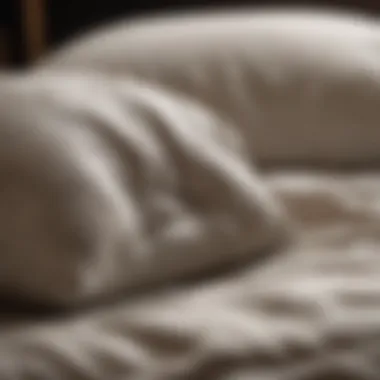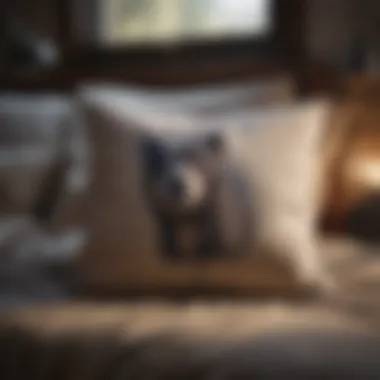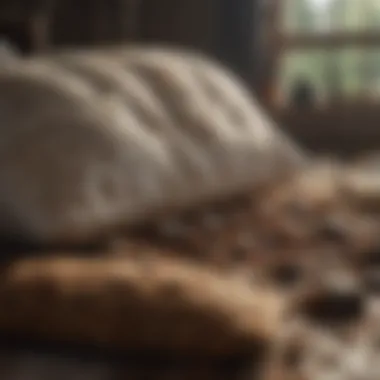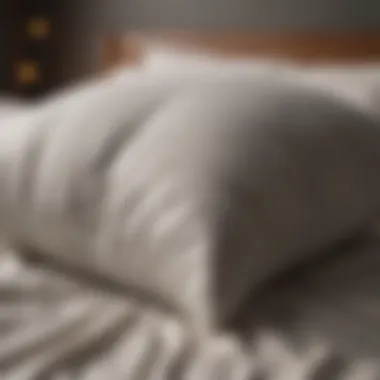Eco-Friendly Ways to Dispose of Old Bed Pillows


Overview of the Topic
Disposing of old bed pillows is often overlooked in discussions surrounding waste management and environmental consciousness. Each year, millions of pillows reach their end of life, contributing to the growing landfill problem. Most people do not realize that these seemingly innocuous items can pose significant problems for the environment if not disposed of properly.
Pillows are typically made from synthetic foams, polyester fibers, or feathers, and this composition affects their disposal options. Many of these materials are not biodegradable and can take years to decompose. Thus, understanding how to dispose of pillows in a way that minimizes environmental impact is essential.
Background information on the significance of the topic
The significance of responsible pillow disposal is steeped in sustainability. By considering eco-friendly options, individuals can reduce their contribution to landfill waste. Additionally, pillows often accumulate dust mites, mold, and other allergens over time. Disposing of them properly can also help mitigate health concerns associated with old bedding. This comprehensive guide aims to shed light on effective strategies for pillow disposal, touching on repurposing and recycling methods that benefit both people and the planet.
Current Status and Challenges
In contemporary society, the status of pillow disposal reflects broader trends in consumer habits and environmental awareness. An increase in disposable consumer products contributes to the overflowing waste in landfills. According to estimates, pillows, alongside bedding and linens, account for a significant portion of textile waste.
Examination of the current state of the natural resource or environmental concern
Currently, many regions lack effective recycling programs specifically aimed at textiles, including pillows. The infrastructure for recycling these items is not as developed as it is for other materials like plastics or glass. Moreover, consumers may not be aware of the implications of tossing pillows in general waste. This misunderstanding of pillow disposal impacts recycling rates and reduces overall sustainability.
Identification of challenges and threats facing the topic
Several challenges hinder effective pillow disposal:
- Lack of awareness: Many people don't know the environmental impacts of improper disposal.
- Limitations of recycling programs: Few municipalities offer services for textile recycling, including pillows.
- Compostability issues: Most pillows are not compostable, creating dead ends in waste management strategies.
Sustainable Solutions
Fortunately, various strategies exist to address the concerns surrounding pillow disposal. Some propose innovative approaches to repurpose pillows before considering them waste. Understanding sustainable practices and solutions can empower individuals to make informed choices about their old bedding.
Exploration of sustainable practices and solutions to address the issues highlighted
One sustainable solution to consider is donating gently used pillows. Organizations such as animal shelters often accept these items for use in pet beds. Additionally, repurposing old pillows can breathe new life into them. Some ideas include:
- Use as stuffing: Pillows can be used for craft projects or as stuffing for cushions.
- Outdoor use: In some cases, old pillows can serve as outdoor seating, especially for events or camping.
Showcase of successful case studies or examples of effective resource management
Different communities have embraced innovative recycling programs to manage textile waste better. For example, cities like San Francisco have implemented textile recycling initiatives that include bedding. These programs demonstrate how recycling efforts can be successful in reducing waste, and they offer excellent models for other regions considering similar paths.
Impact and Importance
The impact of pillow disposal on ecosystems cannot be understated. As landfills grow, they pose risks to local wildlife and surrounding habitats. Furthermore, the accumulation of synthetic materials contributes to larger environmental issues, such as soil degradation and water contamination.
Analysis of the impact of the topic on ecosystems, communities, and future generations
Future generations will face the consequences of today's disposal practices. Pillows that end up in landfills contribute to a cycle of waste that threatens ecosystem health. Communities that prioritize responsible disposal practices can foster a culture of sustainability and ecological stewardship.
Emphasis on the importance of conservation efforts and sustainable resource use
By raising awareness and taking responsible action regarding pillow disposal, everyone can contribute to broader conservation efforts. The importance of sustainable resource use goes beyond just pillows; it extends to all aspects of consumption.
"Every small change in disposal habits can lead to significant environmental impacts over time."
Understanding the Need for Proper Disposal
Disposing of old bed pillows is a topic often overlooked, yet it plays a crucial role in health and environmental conservation. Pillows collect dust mites, allergens, and bacteria over time, making proper disposal necessary. This not only helps maintain personal hygiene but also reduces environmental challenges associated with improper disposal methods.


Key Benefits of Proper Pillow Disposal:
- Healthier Living Environment: Disposing of old pillows mitigates health risks linked to allergens and pests.
- Reduced Environmental Impact: Choosing eco-friendly disposal methods lessens the burden on landfills.
- Conscious Consumerism: Engaging in responsible disposal practices reflects a commitment to sustainability.
Impact of Improper Disposal on the Environment
Improper disposal of old pillows has significant repercussions on the environment. When pillows are thrown away in regular trash, they contribute to the growing landfill crisis. The materials used in synthetic pillows, such as polyester fibers, are non-biodegradable, leading to prolonged environmental persistence. Furthermore, when these materials break down, they can release toxins, which may contaminate soil and water ecosystems.
The accumulation of waste also contributes to greenhouse gas emissions as organic materials decompose anaerobically in landfills. This can accelerate global warming and disrupt local climate patterns. By understanding these impacts, individuals are better positioned to make conscientious decisions regarding pillow disposal.
Health Risks Associated with Old Pillows
Old pillows pose several health risks. They become breeding grounds for dust mites, mold, and bacteria, which can trigger allergic reactions and respiratory issues. According to studies, an unwashed pillow can harbor as many as 16 different kinds of allergens, which makes frequent replacement essential for a healthier sleep environment.
Furthermore, an old pillow may not provide adequate support for the head and neck, leading to discomfort and sleep disturbances. Lack of proper head support can aggravate pre-existing musculoskeletal issues, causing long-term health problems. Therefore, proper disposal of these pillows is not just about reducing waste but also about caring for one’s health and well-being.
"Proper disposal of pillows is not merely a matter of hygiene. It's a step towards a sustainable future."
In summary, understanding the need for proper disposal of old bed pillows highlights its dual importance in promoting health and environmental welfare. Making informed choices aids in reducing waste and supporting a healthier planet.
Identifying the Right Time to Dispose of Pillows
Knowing when to dispose of a pillow is essential for maintaining good health and supporting environmental practices. Pillows can accumulate dust mites, allergens, and bacteria over time, all of which can impact sleep quality and overall health. By recognizing the signs that indicate it's time to replace your pillows, you can take proactive steps to ensure better hygiene and comfort. This section will outline specific signs that your pillows need replacing and discuss the average lifespan of various pillow types, helping you make informed decisions about your bedding.
Signs Your Pillows Need Replacing
Several indicators suggest that your pillow has reached the end of its useful life. Here are key signs to watch:
- Lumps and Clumps: If your pillow has lost its shape or feels lumpy, it is no longer providing essential support. A lumpy pillow can strain your neck and impact sleep posture.
- Odor: Unpleasant smells often signal that mold, mildew, or bacteria have developed inside the pillow. Such odors indicate it may be time to dispose of it.
- Allergy Symptoms: Increased allergies or respiratory issues can suggest that allergens have built up in your pillow. If you experience these symptoms more frequently, check the condition of your pillow.
- Visible Stains: Dark spots or stains can indicate moisture or sweat accumulation. Stains may harbor bacteria, suggesting disposal is necessary.
Recognizing these signs ensures a healthier sleeping environment, allowing for better rest and overall wellness.
The Lifespan of Different Pillow Types
Understanding the lifespan of various pillow materials can aid in determining when to replace them. Here is a breakdown:
- Memory Foam Pillows: These typically last about 2 to 3 years. While they offer wonderful support, they wear down as they become compressed over time.
- Latex Pillows: Generally have a longer lifespan, lasting 3 to 4 years. They are more resistant to dust mites and mold, but they will also lose their firmness eventually.
- Feather and Down Pillows: These usually last around 1 to 3 years. While they are soft and moldable, they may become flat and lose support over time.
- Synthetic Fiber Pillows: These vary widely in quality but generally last between 1 to 3 years. They may not hold their shape and support as effectively as natural materials.
Understanding these lifespans allows you to anticipate when it’s time to replace your pillow. Regularly assessing your bedding can help minimize health risks and accommodate personal comfort.
Assessing Pillow Materials for Disposal Options
Understanding the materials that make up old pillows is crucial for determining the most effective disposal methods. This section aims to explain the various types of pillow fillings and how they impact disposal practices. Knowing whether a pillow is made from synthetic materials or natural fillings influences not only how it can be disposed of but also its environmental impact.
Synthetic vs. Natural Fillings
Synthetic pillows are often filled with materials like polyester or memory foam. These fillings are generally lightweight and inexpensive, making them popular among consumers. However, their composition poses specific challenges when disposed of. Synthetic fillings can take years to decompose in landfills and may release harmful substances into the environment. Recycling options for synthetic pillows are limited, but some facilities can process materials like polyester.
On the other hand, natural filling options include materials like down, cotton, or wool. These pillows tend to be more breathable and can provide better thermal regulation. When disposed of, many natural fibers are biodegradable, making them a more eco-friendly option. They can naturally decompose when composted, reducing harm to the environment. However, proper identification is necessary, as some natural fillings have synthetic blends that complicate disposal.
"Choosing the right disposal method hinges on understanding the material composition of your pillows. Synthetic fillings pose different environmental challenges compared to natural ones."
Eco-Friendly Alternatives
As awareness grows about environmental impact, more consumers are seeking eco-friendly alternatives for pillow disposal. One effective option is recycling. Some companies specialize in recycling old pillows, breaking down the materials to create new products. Always research local programs that facilitate this process, as participation varies by location.


Another meaningful alternative is donation. If pillows are still in usable condition, organizations often welcome clean pillows. Local shelters, animal rescues, and charities may find value in accepting them. Ensure that they meet any hygiene requirements outlined by the receiving organization.
Lastly, consider creative upcycling projects. Pillows can be transformed into various items such as pet beds, cushions, or even craft fabric. These alternatives extend the life cycle of the pillow while minimizing waste.
In summary, assessing pillow materials for disposal not only helps individuals make informed choices but also promotes more sustainable practices. Understanding the differences between synthetic and natural fillings brings clarity to disposal options. Furthermore, opting for recycling, donation, or upcycling can significantly reduce waste, contributing positively to the environment.
Practical Disposal Methods
Disposing of old bed pillows requires a mindful approach. The methods chosen not only affect waste reduction but also illustrate a commitment to environmental responsibility. When pillows are discarded improperly, they contribute to the growing waste problem. Implementing effective disposal methods can reduce this impact significantly.
Recycling Pillows: Where to Start
Recycling pillows is perhaps one of the most effective disposal options available. First, not all recycling centers accept pillows due to the materials involved. Therefore, one must research local facilities. Many times, specialized recycling programs exist specifically for textiles.
Check with local waste management or recycling programs. They may have specific guidelines on how to prepare pillows for recycling. Some facilities require pillows to be clean and dry. Furthermore, research organizations that focus on textile recycling, like Re:loom or Recycling Industries. These entities often accept various types of bedding.
Donation Options for Usable Pillows
Another worthwhile disposal method is donating usable pillows. Many shelters, animal rescues, or charitable organizations often welcome donations of pillows in good condition. Before donating, ensure that pillows are clean and free from significant damage. Some suitable options for donation include:
- Homeless shelters
- Women's shelters
- Animal shelters
- Local charities
It is important to call ahead. Ask about their specific needs and any restrictions they may have. Remember that donating is a great way to extend the life cycle of the pillow while also serving the community.
Composting Natural Fill Pillows
For those with pillows made of natural materials such as cotton or wool, composting is an excellent option. Natural fibers can break down easily in compost piles, contributing to nutrient-rich soil. When composting, the pillow must be dissected. Remove the outer fabric to expose the filling.
Ensure the filling is purely natural without synthetic blends. Any synthetic materials could disrupt the composting process. Additionally, mix the natural fiber with other compost materials to promote effective decomposition. Composting offers a sustainable way to dispose of old pillows, returning resources to the earth.
Creative Upcycling Ideas
Creative upcycling serves as a sustainable solution for discarding old bed pillows, presenting a dual benefit of reducing waste while giving new life to items that might otherwise end up in landfills. The essence of upcycling lies in its transformative approach; it encourages individuals to reimagine the potential of everyday objects. By engaging in such practices, consumers can significantly contribute to environmental preservation efforts. Moreover, these projects foster creativity and resourcefulness, aligning with the growing global emphasis on sustainability.
Transforming Old Pillows into Pet Beds
One practical approach to upcycling is converting old pillows into pet beds. This method offers an affordable and eco-friendly solution for pet owners. The process requires minimal materials: simply cut the pillow open and remove its filling. Depending on the type of pillow, the filling can be comprised of synthetic or natural materials. Here is a simple guide to creating a pet bed:
- Choose a Pillow: Select an old pillow that has lost its shape or support.
- Prep the Scaffold: Use a durable fabric to create an outer covering, ensuring it is pet-friendly and easy to clean.
- Filling: Insert the pillow filling into the new cover. You may combine various fillings for added comfort.
- Seal It Up: Stitch or securely close the opening. This ensures that your pet cannot access any potentially harmful materials.
- Test It: Give the newly made bed to your pet and observe their reaction. Often, pets love the familiarity of repurposed items.
This project supports waste reduction efforts while delivering comfort to pets. It is a win-win situation for both owners and their furry companions.
Craft Projects for Pillow Fabric
Another engaging way to upcycle is by utilizing the fabric from old pillows in craft projects. The various materials often used for pillow covers, such as cotton, linen, or polyester, can be repurposed into a range of useful and decorative items. Here are some project ideas to consider:
- Throw Pillows: Use the original fabric to create smaller throw pillows for couches or chairs. This allows for customization in size and filling.
- Fabric Tote Bags: The durable fabric can be transformed into functional tote bags. The simple sewing technique involves cutting and sewing the fabric to create a stylish accessory.
- Quilts or Blankets: Combine fabric from multiple pillows to create a unique quilt. This project showcases creativity while offering a functional product.
- Decorative Wall Hangings: Use the fabric pieces to craft a wall hanging. This artistic expression can personalize living spaces while recycling materials.
Utilizing pillow fabric in these creative ways not only minimizes waste but also allows individuals to express their creativity and resourcefulness. The variety of potential projects reflects the versatile nature of fabric and transforms ordinary items into striking decorations or practical goods.
Commercial Solutions for Pillow Disposal
Pillows, despite their comfort, pose a challenge when it comes time to dispose of them. Widespread awareness of environmental issues has increased the urgency of finding effective disposal methods. Commercial solutions are key in addressing this matter. Businesses and organizations can play a significant role in promoting sustainable practices around pillow disposal.
The importance of commercial solutions extends beyond mere convenience. They offer systematic approaches that cater to both individuals and communities. Companies involved in recycling programs take the lead by providing infrastructure designed for proper pillow disposal. This can reduce the landfill waste significantly. Additionally, some businesses specialize in materials recovery, ensuring that the components of old pillows are repurposed and used again. The environmental benefits cannot be understated, as they contribute to a circular economy.


Pillow Recycling Programs
Pillow recycling programs are becoming increasingly prevalent in many urban areas. These initiatives enable individuals to drop off unwanted pillows at designated locations. The pillows collected undergo a sorting process where materials are categorized according to type. For instance, synthetic fillings may be processed differently than natural materials.
Some key benefits include:
- Reduces landfill waste: Proper recycling can significantly lessen the amount of waste sent to landfills.
- Resource Recovery: Recycling prevents valuable materials from being wasted and sources them for new products.
- Community Awareness: Such programs often engage communities, raising awareness about the importance of proper disposal and recycling practices.
Proper disposal practice helps in maintaining a healthier planet while reducing personal waste.
Several organizations offer recycling solutions, such as the Earth911 or Recycling Networks. They often provide good resources on where to find local recycling options for pillows and other bedding materials. Advocating for these programs can elevate environmental consciousness in various communities.
Professional Disposal Services
Another option for pillow disposal involves engaging professional services. Many waste management companies have adapted their strategies to include specialized disposal solutions for items that do not fit traditional waste criteria. This can include anything from pillows, mattresses, to other bedding items.
The advantages of using professional disposal services are clear:
- Convenience: They manage the entire process, from pickup to responsible disposal, which is easier for individuals.
- Expertise: These companies have the knowledge and tools to handle disposal safely and effectively.
- Environmentally Friendly Options: Many of these companies emphasize eco-friendly methods, ensuring that the materials do not end up in landfills unnecessarily.
It is essential to select a reputable service that follows proper recycling and disposal guidelines. Researching local businesses and reading customer reviews can assist in finding a reliable company.
Best Practices for Pillow Care to Extend Lifespan
Proper care of bed pillows is essential for both prolonging their lifespan and ensuring a healthy sleeping environment. Beyond simply extending usage, maintaining pillows can contribute to a reduction in waste, which aligns with the broader goals of environmental conservation. Pillows collect dust, allergens, and bacteria over time, making regular cleaning and maintenance crucial for hygiene. Here, we present effective strategies to ensure your pillows remain in optimal condition for longer.
Regular Cleaning and Maintenance
Cleaning pillows should be a consistent part of your home care routine. Most pillows can withstand washing, but it's important to check the care labels first for specific instructions. Generally, synthetic pillows can typically be machine washed using a gentle cycle with a mild detergent. Memory foam pillows, however, require spot cleaning, as submerging them can distort their shape.
Here are some key points on how to maintain cleanliness:
- Washing Frequency: Aim to wash your pillows every 3-6 months. This prevents dust mite accumulation and extends the lifespan of the filling.
- Drying: Once washed, ensure pillows are completely dried. Use dryer balls or clean tennis balls while drying to maintain their fluffiness.
- Pillowcases and Covers: Change pillowcases regularly, ideally once a week, to minimize allergens and dirt.
In addition, shake out your pillows and let them air out every few weeks. Exposure to fresh air and sunlight helps in killing bacteria and keeping them fresh.
Using Protective Covers
A protective cover is a simple yet effective means to prolong the life of bed pillows. These covers can act as a barrier against spills, sweat, and allergens. Investing in breathable, waterproof covers can safeguard against moisture damage, which is a common issue that leads to pillow deterioration.
Consider the following aspects regarding protective covers:
- Material Choice: Select covers made from materials like cotton or polyester blends. These are both durable and breathable, allowing for easy maintenance.
- Fit and Style: Ensure that the cover fits snugly around the pillow to provide maximum protection without altering comfort.
- Cleaning: Wash protective covers regularly to maintain their effectiveness. Just like pillowcases, aim for a weekly cleaning schedule.
Using protective covers does not only extend pillow life, but also enhances the overall sleeping environment by reducing allergen exposure.
"A good pillow care routine not only maintains hygiene but also minimizes environmental impact by extending the lifecycle of the product."
By prioritizing regular cleaning and utilizing protective covers, you take significant steps toward extending pillow lifespan while promoting responsible disposal practices when the time comes to replace them.
Ending: The Responsibility of Pillow Disposal
Disposing of old bed pillows may seem like a trivial task. However, it carries significant weight, especially in today's world where waste management and environmental impact are critical issues. Proper disposal goes beyond merely throwing a pillow in the trash. It encompasses understanding the materials involved, the implications of waste on the environment, and the social responsibility of consumers.
Understanding the Impact
Improper disposal can contribute to landfill overflow, which exacerbates pollution, affects wildlife, and ultimately harms the planet. Through responsible pillow disposal, individuals can actively participate in reducing waste and promoting sustainability. Engaging with recycling programs or considering donation options not only helps the environment but also supports communities in need.
Consumer Choices Matter
When consumers prioritize eco-friendly disposal methods, they send a message to manufacturers about the importance of sustainable practices. The choices made in pillow disposal can influence broader systemic changes in production and waste management. It challenges the status quo where convenience often overshadows responsibility.
"Every action counts in the quest for sustainability; pillow disposal is just a piece of the puzzle."
Benefits of Responsible Disposal
By choosing to recycle or donate old pillows, consumers help decrease the demand for raw materials needed in production. It ultimately leads to a reduction in resource depletion and pollution. Educating oneself and others about effective disposal methods fosters a culture of environmental stewardship.
This article highlights the urgency and relevance of the conversation around pillow disposal. As consumers, taking proactive steps to manage waste not only simplifies individual effort but also contributes collectively towards a healthier planet. The responsibility lies not just in disposing of pillows but in recognizing the larger implications these actions carry into the future of environmental conservation.



